AMD Ryzen 5 2400G and Ryzen 3 2200G Integrated Graphics Frequency Scaling
by Gavin Bonshor on September 28, 2018 12:30 PM EST- Posted in
- CPUs
- AMD
- GPUs
- Overclocking
- Zen
- APU
- Vega
- Ryzen
- Ryzen 3 2200G
- Ryzen 5 2400G
Ryzen APU Integrated Graphics Scaling
Our of our promised Ryzen APU scaling articles, overclocking the integrated graphics was the most requested. Given that the Ryzen 5 2400G and Ryzen 3 2200G are marketed towards gamers on a budget, the gaming performance is perhaps the most important aspect to most users looking to purchase one for their system.
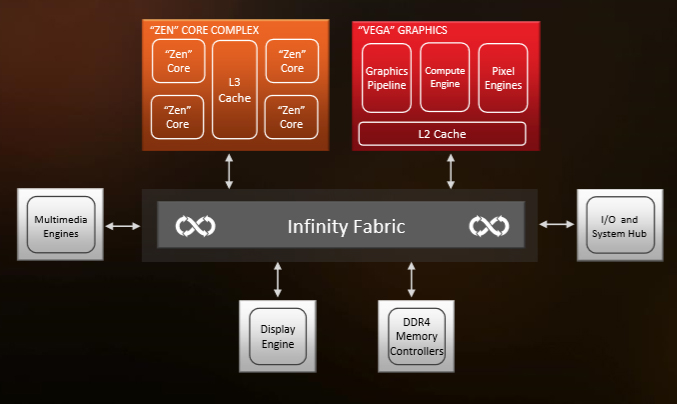
The Raven Ridge APU layout Highlighting the Infinity Fabric Interconnect
We have seen that the Infinity Fabric interconnect used within the SoC benefits from the use of faster memory in our Ryzen APU memory frequency scaling testing - because the Infinity Fabric and memory speed are directly linked, the CPU cores and GPU cores can communicate between the different areas faster. When overclocking a system for more performance, it all comes down to identifying the bottlenecks. Multiple bottlenecks can be in play at once, such as CPU frequency, GPU frequency, memory speed, and interconnect speed. As our set of articles on APU scaling have progressed, the final one left to analyze was GPU frequency. Hence, this review.
Scaling the APU, One Step (50 MHz) at a Time
For our overall analysis, we are splitting the data into two sets.
First up is the performance difference when simply overclocking the integrated graphics. Stepping up the frequency, as shown on the previous pages, usually increases performance, but here we will tell you how much in all four key areas: 2400G frames per second and percentile results, as well as 2200G frames per second and percentile results.
The second is to compare maximums. We have data now with the maximum tested integrated graphics frequency (1600 MHz) and the maximum tested CPU core frequency (3.9 GHz). The question becomes how much of a difference does overclocking one over the other make for gaming. The answer would normally sound obvious, but this is something we want to quantify. If a gamer has a choice between overclocking the CPU or the GPU, what should the target be, and how much should they expect? This data answers that question.
Group 1: 1600 MHz vs Stock
When comparing the results with the Ryzen 2000 series APUs at their stock settings against an overclock of 1600 MHz yields some good results across the majority of the titles tested in our testing suite.
Starting with the average frame rates, the Ryzen 3 2200G showed the biggest gains across the board, with the biggest benefits of overclocking in more graphically intensive games such as Total War: Warhammer 2 and Rise of the Tomb Raider. The 2400G, with its 28% overclock, pushed above 10% in Warhammer 2 and F1 2017, looks like it did not gain as much as the 2200G, but this is due to the lower percentage gain over the stock performance.
Focusing specifically on the 99th percentiles from the testing, the results given were erratic to say the least. All test results were repeatable across operating system reinstalls, but the 2400G showed regression in Shadow of Mordor and Warhammer 2. By contrast, the 2200G saw gains in both of those titles, a minimum of 8% across the board, and several titles scored around a 30% gain. For a 45% overclock, this is pretty good.
Group 2: What is Better, CPU OC or IGP OC?
In this set of results, we compare the uplift gained from a full GPU overclock to a full CPU overclock. This is to show which component of the chip provides the biggest benefit to frame rate performance in games: CPU or graphics. While increasing the CPU frequency is beneficial in improving performance in computationally dependent tasks such as video encoding, rendering and compression tasks, games should enjoy the graphics much more.
In our 2400G results, the winner between the two is clearly the integrated graphics. The CPU data shuffles around the same frame rates, not offering much benefit, while overclocking the GPU gives at least 5% extra frame rates across the board.
As the 2200G starts off from such a low point, overclocking both the CPU and GPU gets extra performance in almost every title. However, only overclocking the integrated graphics gets a good 10% gain across the board as a minimum, but more like 24%+ on games like F1 2017, Rise of the Tomb Raider, and Warhammer 2.
So while the analysis here is perhaps not as long-winded as our memory scaling and core frequency scaling pieces, the crux is that the integrated graphics is the key factor in gaming performance and despite the Infinity Fabric Interconnect combined with faster memory displaying a positive showing in our Ryzen 2000 series memory scaling analysis, the integrated graphics does offer more from a gamers standpoint. Of course, combining faster memory on top of an already overclocked Ryzen 2000 series iGPU is going to be the golden crown.
The Ryzen APUs; iGPU vs Core Frequency Plus Memory Frequency
When we took a look at how CPU Core Frequency Scaling with the Ryzen 5 2400G and Ryzen 3 2200G, we saw that the majority of the benefits came in compute heavy related tasks, and even gaining a distinct advantage when gaming with a discrete GPU. The gaming performance by just overclocking the CPU core frequency didn’t yield the results expected when using integrated graphics. In our dive into Memory Scaling on Zen and Vega, the consensus was that memory has a much greater effect on gaming performance than CPU frequency, as well as memory reliant applications and programs. Now while the focus has been purely on gaming this time around, which is to be expected given the target market AMD has aimed the Ryzen APUs firmly at, the results in some cases made a large difference in average frame rates; 99th percentiles on the whole did improve as the integrated graphics frequency went up, but some of the results were a little erratic, sometimes surpassing the overclock percentage jump.
For gaming, the extra performance gained in relation to the increase in graphics frequency is absolutely paramount in situations where average frame rate sits just below a key metric such as 720p60 or 1080p30. Gaming at 1080p60 is a little too much of a stretch for the integrated Vega cores, unless the game engine is less complex such as with titles such as MOBAs like DOTA 2, League of Legends and more recently, games like Fortnite being fine for this mixture of resolution and frame rate. As we found out in our Ryzen APU Overclocking Guide and Results article, the Ryzen APUs tend to prefer either high CPU frequencies or higher integrated graphics frequencies, but not both at the same time.
This means that users can choose which element of performance they want to improve, if the system is for compute related tasks or gaming. For any compute related workloads, the integrated graphics frequency is ineffective whereas pure MHz on the Ryzen cores and memory frequency can play a major part in improving performance throughput.
| Recommended Reading on AMD Ryzen APUs | |||
| 2400G Review | 2200G Review | Overclocking | Delidding |
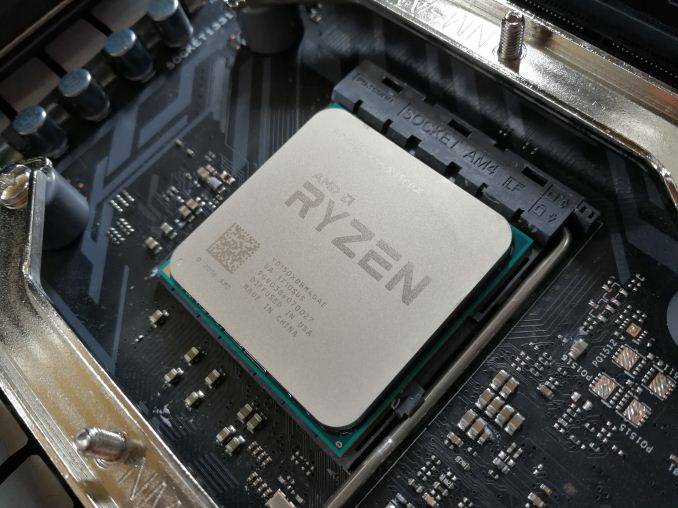 |
 |
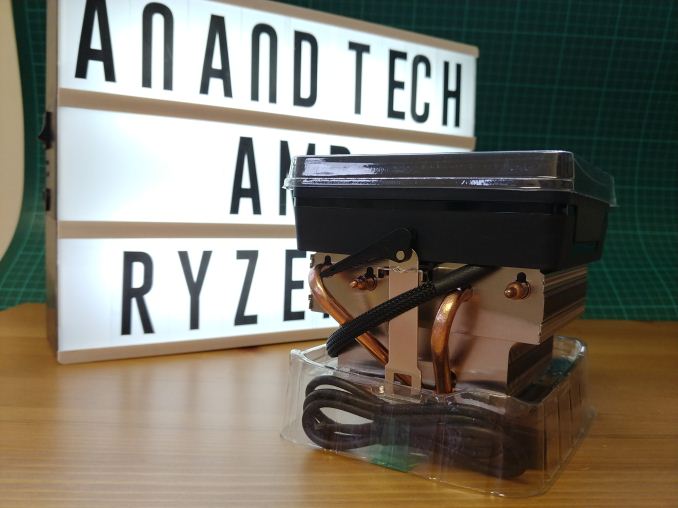 |
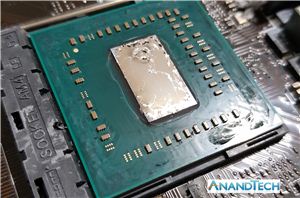 |
| Core Scaling | Memory Scaling | Graphics Scaling | Best CPUs |
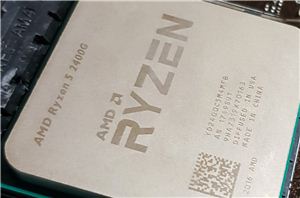 |
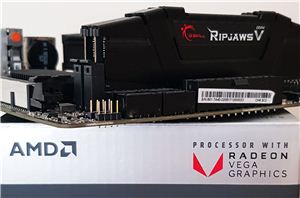 |
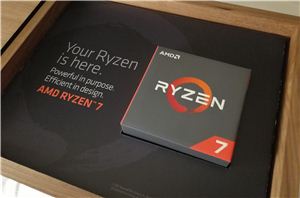 |
|


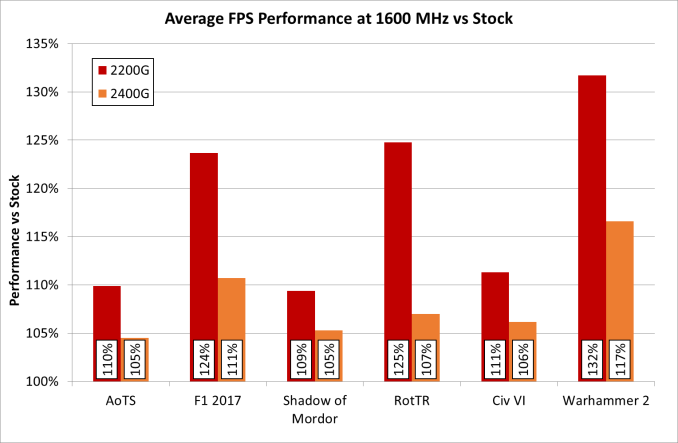
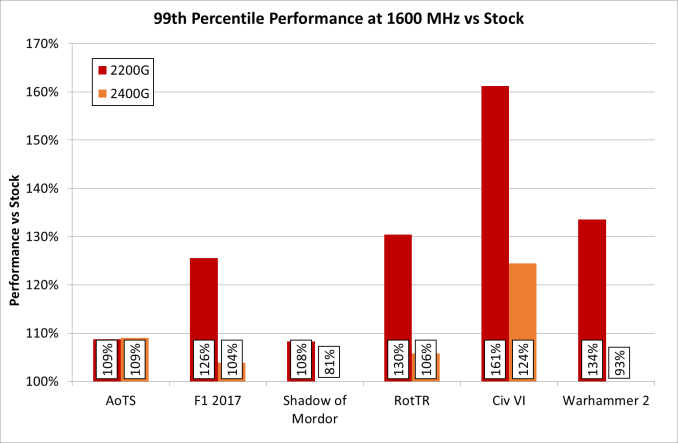
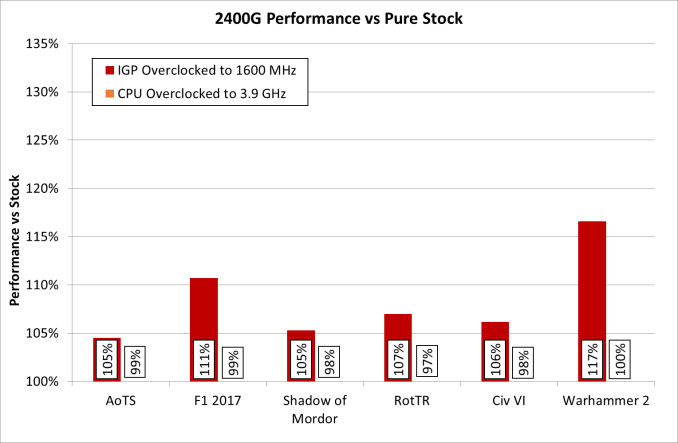
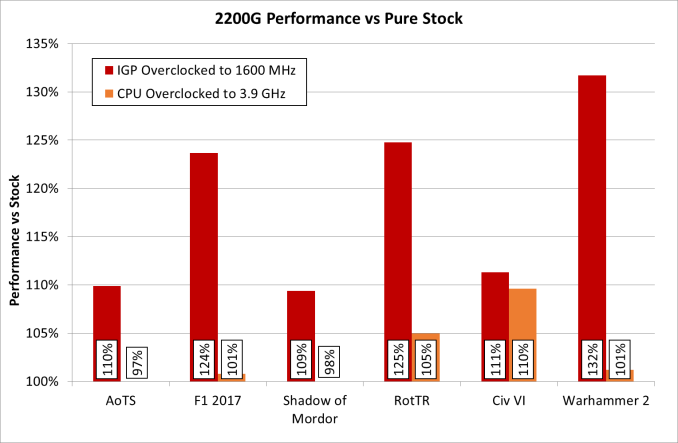
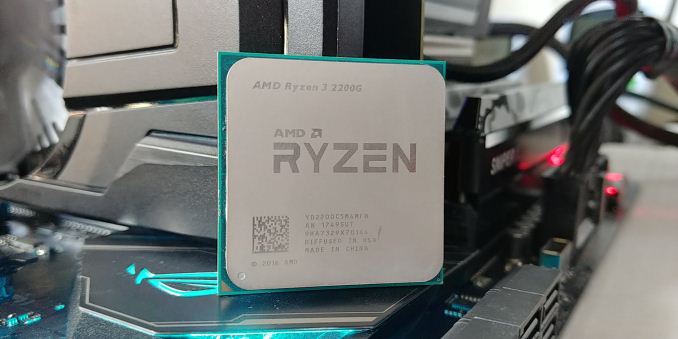








49 Comments
View All Comments
neblogai - Saturday, September 29, 2018 - link
Or a €10 Deepcool Gammaxx 200T, €15 Gammaxx 300, etc.lightningz71 - Saturday, September 29, 2018 - link
If you keep the overclock reasonable. Keep the CPU stock and push the iGPU to 1600mhz. If you push higher, it starts demanding a lot of SOC voltage, which hurts the memory controller performance. There are a few B450 boards with decent 2 phase SOC sections that would be fine there. The problem is having the option in the BIOS to actually overclock the iGPU.dromoxen - Sunday, September 30, 2018 - link
I dont think ppl are are able to push higher, 1600mhz seems to be pretty much the outer limit. It appears that the greatest increase is going from 1100mhz to 1150mhz after that the gains are much less. Power draw and heat would be nice to know . I would like to have one of these in a nuc style system as a tellybox maybe the ge's will suit better. They can only get more popular if Intel cant supply Budget chips for next 9 monthseastcoast_pete - Saturday, September 29, 2018 - link
Gavin, thanks for this last chapter of the Zen APU reviews! As mentioned by others here, it would be helpful if you could post the power draw (even just overall) figures; they usually give a good idea how much of a sweat the silicon works up. The other point is that if I would OC either the CPU or GPU on a 2200G or 2400G, I would at least try to OC the memory a bit, too. With graphics likely limited by memory speed, that seems to be a logical thing to try. If you did, any information on that combo (OC'd graphics plus OC'd memory) would be appreciated! It doesn't have to be a full list of all OC permutations.ballsystemlord - Saturday, September 29, 2018 - link
You wrote the wrong APU name down in the paragraph reading "Performance in Shadow of Mordor wasn't the best we have seen from the game testing, with average framerates gradually increasing on the 2400G."You were testing the 2200G in that section.
I know it's easy to make that mistake, I do it too.
Haawser - Saturday, September 29, 2018 - link
"For any compute related workloads, the integrated graphics frequency is ineffective whereas pure MHz on the Ryzen cores and memory frequency can play a major part in improving performance throughput. "Implying that memory overclocking isn't useful for graphics too ? Why didn't you try overclocking the graphics *and* memory, seeing as both are easy to do ? And 90% of APU users interested in gaming will anyway ?
eva02langley - Saturday, September 29, 2018 - link
I am having a similar motherboard, the MSI B450i Gaming AC plus, and the same behavior between 1350-1400MHz happen.I just put the iGPU at 1500MHz with 1.2V and it is running flawlessly in games.
Also, I am experiencing strange blinking black screen once in a while. It is like a blinking of an eye. It is kind of annoying.
Do you experience the same thing?
wilsonkf - Sunday, September 30, 2018 - link
Why don't you test at least one more faster memory speed (e.g. 3466Mhz)? This would be interesting.hashish2020 - Tuesday, October 2, 2018 - link
I hope that they end up doing that, because that will likely be the sweet spot for casual gamers like me who are thinking about getting back into building desktops.lightningz71 - Tuesday, October 2, 2018 - link
The memory controller on the 2400G is not improved over Zepplin in any measurable way. It gets unstable quickly past 3200/3333 (though, with very loose timings and good samples, there are OC examples in the 3400 range, though, stability is questionable.)Buildzoid on reddit has a video on testing. He showed that B-die can net you tight timings at 3200/3333/ but gets VERY hot above that. E-Die was showing stability and lower temperatures at 3400, but, the timings were looser to get there. No matter what, his performance testing showed that 3200/3333 with tight timings were just as fast as 3400 with loose timings, and more achievable. His absolute fastest times were with UNSTABLE runs of B-Die at 3400+ mhz with passable timings, but it required considerable cooling to occasionally complete a test.
The advantage to keeping the memory at 3200/3333 with tight timings is that you can run a bit more SOC voltage and maybe get a bit more out of the iGPU. 1600 is a reasonable overclock, but, with a bit more voltage, people are getting it past 1650 and sometimes 1700.
I haven't seen delidding results on iGPU overclocking with memory overclocking at the same time.